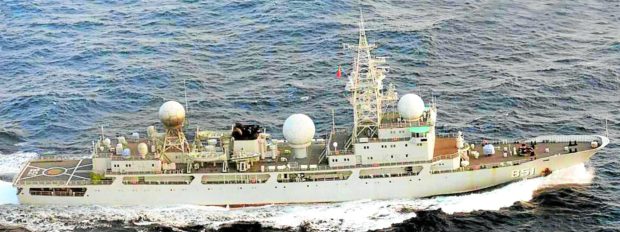
LISTENING SHIP | The Chinese People’s Liberation Army Navy (PLAN) has developed ships, such the Dongdiao-class PLAN 815 in this photo, to listen in on naval operations of other nations. These ships’ main tasks are to monitor and analyze electronic signal intelligence using sophisticated equipment and radar. (Photo from JAPAN MINISTRY OF DEFENSE)
MANILA, Philippines — The Dongdiao-class electronic reconnaissance ships of the Chinese navy have been previously reported snooping near the coasts of other countries for intelligence-gathering and monitoring war games, according to maritime experts.
Last month’s incident in the Sulu Sea — where one ship of this type lingered for three days apparently to keep an eye on an ongoing Philippine-US joint military drills off Palawan — could be latest known instance of eavesdropping by the People’s Liberation Army Navy on the military of a sovereign nation right inside its territorial waters.
“In other cases, they were doing it in the high seas, where it could be regarded as among the high seas freedoms. This one is in archipelagic waters subject to Philippine sovereignty, so we have the right to protest,” said Professor Jay Batongbacal, director of the University of the Philippines Institute for Maritime Affairs and the Law of the Sea.
The Department of Foreign Affairs on Monday said it had summoned Chinese ambassador Huang Xilian to convey its displeasure over the “illegal intrusion and lingering presence” of China’s Dongdiao-class PLAN 792 in Philippine waters.
In July 2018, an identical surveillance ship entered Japan’s territorial waters during a US-led exercise, prompting Tokyo to lodge a protest. But China said its ship’s passage was part of its freedom of navigation.
Militia backup
In December of the following year, the Indian government expressed concern that a Dongdiao-class vessel “infiltrated” the Indian Ocean and stayed for two weeks in the region where New Delhi had established naval bases and deployed warships.
In addition to its conventional ships, the Chinese navy is backed by hundreds of maritime militia vessels, many of them deployed to disputed parts of the South China Sea, including the West Philippine Sea.
PLAN 792 entered the Sulu Sea without permission from Manila and stayed there from Jan. 29 to Feb. 1, while the Philippines-US Marines Exercise 2022 (Marex 22) was underway off the eastern coast of Palawan. Senior military officials suspect that the Chinese navy was watching and eavesdropping on the exercise.
The Philippine Navy’s BRP Antonio Luna (FF-151) repeatedly told the Chinese vessel to leave, but it refused.
“It’s a practice of the PLAN to monitor naval exercises. They did it in Rimpac (Rim of the Pacific) and exercises in Australia. The US also does the same. The only complication is they (China) entered the archipelago,” said retired Rear Adm. Rommel Jude Ong, a professor at Ateneo de Manila University’s school of government.
Intel work
The 6,000-ton Dongdiao-class ships are fitted with sophisticated communications systems and radars designed to monitor and eavesdrop on other militaries.
Last year, these ships were reported in Australia to be doing intelligence gathering near military bases and observing an American-led multinational exercise, but it faced no objections because these were operating in international waters.
These ships were also reported close to other joint exercises involving the US Navy in recent years, but in international waters.
China insisted that PLAN 792 was exercising “innocent passage” during last month’s incident in the Sulu Sea.
But the Department of Foreign Affairs said the actions of the PLAN 792 “did not constitute innocent passage and violated Philippine sovereignty.”
China has no claims to the Sulu Sea, a major part of the Philippines’ archipelagic waters. But it claims nearly the entire South China Sea, including the West Philippine Sea, waters within the country’s exclusive economic zone.
Don’t delay protest
An international arbitral tribunal ruled in 2016 to invalidate China’s historical claims, which are loosely demarcated by its so-called nine dash line.
Batongbacal believes China had deployed PLAN 792 during the Marex 22 exercises as it was keenly interested in the military, particularly naval, capabilities of the Philippines and the United States.
“It gives them the opportunity to observe the amphibious operations of those involved,” he said.
Ong suggested that rules of engagement be adopted by Philippines and US forces engaged in joint exercises in case a similar situation occurs in the future.
“There will be Balikatan exercises in April, there should already be a plan ahead of that,” he said.
The Balikatan is the largest of the joint military exercises involving Philippine and US troops. Some countries are occasionally invited to observe the drills.
Batongbacal and Ong both agree that in the future, the Philippine government must protest against these Chinese actions and publicize such incidents as soon as they happen “instead of delaying it for a month.”
RELATED STORIES
Chinese ship ‘spied on PH-US war games’
‘Innocent passage’: China defends ship’s illegal intrusion in Sulu Sea